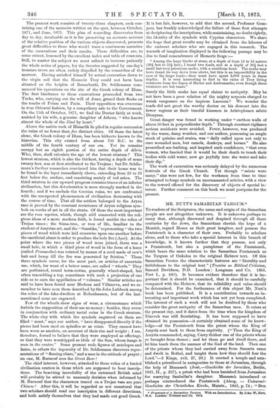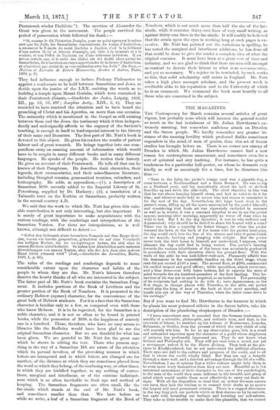MR. NUTT"S SAMARITAN TARGUM.*
To readers of the Scriptures, the name and origin of the Samaritan people are not altogether unknown. It is unknown perhaps to- many that, although disowned and despised through all these centuries by the Jews, the Samaritans cherish the hope of a Messiah, regard Moses as their great lawgiver, and possess the Pentateuch in a character of their own. Probably to scholars alone, and to those who take a special interest in this branch of knowledge, is it known further that they possess, not only a Pentateuch, but also a paraphrase of the Pentateuch, which bears the same relation to the Samaritan Pentateuch as the Targum of Onkelos to the original Hebrew text. Of this Samaritan Version the characteristic features are "literality and faithfulness to the original text" (Treatise on Biblical Criticism, Samuel Davidson, D.D. London : Longman and Co. 1856. Part I., p. 240). It becomes evident therefore that it is im- portant that it should be examined, that it should be carefully compared with the Hebrew, that its reliability and value should be determined. For the furtherance of this object Mr. Nutt's book has been published. It is a contribution towards an in- teresting and important work which has not yet been completed. The interest of such a work will not be doubted by those who consider the great antiquity of the Samaritan race. It exists at the present day, and it dates from the time when the kingdom of Nineveh was still flourishing. It has been supposed to have obtained its possession—it certainly obtained some of its know- ledge—of the Pentateuch from the priest whom the King of Assyria sent back to them from captivity. ("Then the King of Assyria commanded, saying, Carry thither one of the priests whom ye brought from thence ; and let them go and dwell there, and let him teach them the manner of the God of the land. Then one of the priests whom they had carried away from Samaria came and dwelt in Bethel, and taught them how they should fear the Lord."-2 Kings, xvii. 27, 28.) It erected a temple and esta- blished a priesthood in antagonism to those at Jerusalem, through the help of Manasseh (Jost,—Geschichte der Israeliten, 1821,11., p. 257), a priest who had been banished from Jerusalem for marrying Sanballat's daughter. Manasseh introduced or perhaps reintroduced the Pentateuch (Alzog, — Universal- Geschichte der Christlichen Kirche, Maintz., 1843, p. 74; "Den * Fragments of a Samaritan Tarpon. With an Introduction. By John W. Nutt, M.A. London: TrUbner and Co. 1874. Pentateuch wieder Einfiihrte "). The sanction of Alexander the -Great was given to the movement. The people survived the -period of persecution which followed his death :— " Si, comma le dit l'historien Josaphe, pour no point epronver le memo sort quo les Juifs, les Samaritains consentirent, du temps d'Antiochua, eonsaerer le Temple du mont Garizim a Jupiter' &est la la foiblesse d'une nation lash° et denude d'energie, qui cede a la tyrannie et a Is crainte, et non l'effet de l'opinion on d'une tolerance inveteree. II eat moms certain quo, silo culto des idoles efit ete etabli Mors parmi lea 'Samaritains, ils n'auroient en rien a apprehender de is fureur d'Antiochus, et n'auroient pas craint de se voirconfondus avec lea Julie* (De Sacy,— Notices et Extra its de Divers Manuserits, Arabes et Autres, Paris, 1829, p. 3).
'They had influence enough to induce Ptolemy Philometor to -appoint a conference to be held between Samaritans and Jews, to decide upon the justice of the LXX. omitting the words as to
building a temple upon Mount Gerizim, which were contained in their Pentateuela (Graetz,—Geschichte der Juden, Leipzig, 1856, pp. 52, 53, 497; Josephus Antiq., X.M., 3, 4). They are recorded to have received the attention and to have heard the preaching of Christ and his Apostles, on more than one occasion. The animosity which is mentioned in the Gospel as still existing between them and the Jews, the testimony which it thus indepen- dently and undesignedly affords to the cogency of the Saviour's teaching, is enough in itself to lend especial interest to the history of their name and literature. The first part of Mr. Nutt's book is devoted to this object. He gives his readers the results of patient labour and of great research. He brings together into one com- pendious essay an amazing amount of information which would have to be sought in many different books and in nnmy different languages. He speaks of the people. He recites their history. He gives an account of their Pentateuch. He tells all that can be known of their Paraphrase. He describes their chronicles, their legends, their commentaries, and their miscellaneous literature, including liturgical remains, grammatical treatises, calendars, and lexicography. He adds, as appendices,—(1), a description of Samaritan MSS. recently added to the Imperial Library of St. Petersburg, supplied by Dr. Harkavy ; (2), a translation of a Talmudic tract on the Kuthim or Samaritans, probably written in the second century A.D.
We said that the work to which Mr. Nutt has given this valu- able contribution is not only interesting, but also important. It is surely of great importance to make acquaintance with the various readings, with the renderings and interpolations of the Samaritan Version. For there are interpolations, as is well known, although not difficult to detect :—
" Selbst don Gebrauch eines besondern Tempels nut dem Berge Geri- rim, woven wir bereits gesprochen, grfindeten sie auf eine Vorschrift des heiligen Buches, die sic nachgetragen haben, die sich aber in unsern Bfichern nicht befindet. So haben ihre Abschriften noch mehrere Abweichungen von unsern Texten, aber elle der Art, dass eine spiitere Hand leicht erkannt wird" (Jost,—Geschiehte der Israeliten, Berlin, 1820, I., p. 65).
The value of the readings and renderings depends to some considerable extent upon the character and habits of the people to whom they are due. Mr. Nutt's labours therefore deserve the hearty thanks of all who are interested in the subject. The latter part of Mr. Nutt's book contains the Samaritan Frag- ment. It includes portions of the Book of Leviticus and the greater portion of the Book of Numbers. It is presented in the ordinary Hebrew (square) character, for the convenience of the great bulk of Hebrew students. For it is a fact that the Samaritan character is familiar only to a few, as compared even with those who know Hebrew. It is 'to be regretted, for the Samaritan is a noble character, and it is not so often to be found in printed books, while the possession of MSS. is the happiness of scarcely one in a hundred. Those, therefore, who have no easy access to libraries like the Bodleian would have been glad to see the original Samaritan character. But we are thankful for what has been given. We are grateful to Mr. Nutt for the great care which he shows in editing the text. Those who possess any- thing in the way of a Samaritan MS. are aware of the attention which its perusal involves, of the provoking manner in which letters are transposed and in which letters are changed one for another, of the distance at which they are sometimes placed from the word to which they belong, of the confusing way, at other times, in which they are huddled together, to say nothing of correc- tions, marginal and interlinear, or of the extreme indistinct- ness which is so often inevitable to their age and method of keeping. The Samaritan fragments are often small, like the fac-simile which stands at the end of Mr. Nutt's book, and sometimes smaller than that. We have before us while we write, a leaf of a Samaritan fragment of the Book of
Numbers, which is not much more than half the size of the fac- simile, while it contains thirty-two lines of very small writing, as against thirty-one lines in the fac-simile. It will readily be believed that the strain upon the eyes in working long at such pages is ex- cessive. Mr. Nutt has pointed out the variations in spelling, he has noted the marginal and interlinear additions, he has done all that cotild be done to give the reader a complete idea of what the original contains. It must have been at a great cost of time and industry, and we are glad to think that there are men still amongst us content to devote their labour to what is so unremunerative, and yet so necessary. We rejoice to be reminded, by such works as this, that solid scholarship still exists in England. Mr. Nutt takes a high place amongst scholars, and the present work is creditable alike to his reputation and to the University of which he is an ornament. We commend the book most heartily to all those who are concerned in the subject.



































 Previous page
Previous page